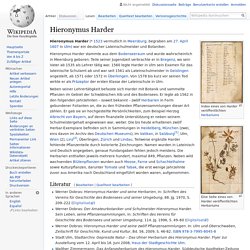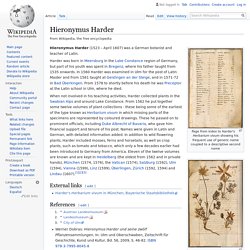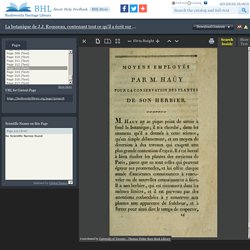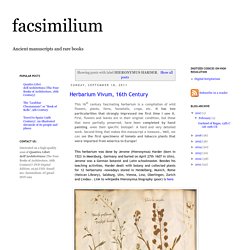

Hieronymus Harder. Index eines von Harder veröffentlichten Herbariums Eine Seite eines von Harder veröffentlichten Herbariums Hieronymus Harder (* 1523 vermutlich in Meersburg; begraben am 27.

April 1607 in Ulm) war ein deutscher Lateinschulmeister und Botaniker. Hieronymus Harder stammte aus dem Bodenseeraum und wurde wahrscheinlich in Meersburg geboren. Teile seiner Jugendzeit verbrachte er in Bregenz, wo sein Vater ab 1535 als Lehrer tätig war. 1560 legte Harder in Ulm sein Examen für das lateinische Schulamt ab und war seit 1561 als Lateinschulmeister in Geislingen angestellt, ab 1571 oder 1572 in Überkingen. Literatur[Bearbeiten | Quelltext bearbeiten] Werner Dobras: Hieronymus Harder und seine Herbarien, in: Schriften des Vereins für Geschichte des Bodensees und seiner Umgebung, 88. Weblinks[Bearbeiten | Quelltext bearbeiten] Hieronymus Harder - Wikipedia. Page from index to Harder's Herbarium vivum showing his frequent use of generic name coupled to a descriptive second name Hieronymus Harder (1523 – April 1607) was a German botanist and teacher of Latin.

Harder was born in Meersburg in the Lake Constance region of Germany, but part of his youth was spent in Bregenz, where his father taught from 1535 onwards. In 1560 Harder was examined in Ulm for the post of Latin Master and from 1561 taught at Geislingen an der Steige, and in 1571-72 in Bad Überkingen. From 1578 to shortly before his death he was Preceptor at the Latin school in Ulm, where he died.
When not involved in his teaching activities, Harder collected plants in the Swabian Alps and around Lake Constance. External links[edit] HdN 3A 0021 0022. Harder Hieronymus 3. Historia plantarum et vires ex Dioscoride, Paulo Aegineta, Theophrasto, Plinio, & rece[n]tioribus Graecis, iuxta elementoru[m] ordine[m] / If you are generating a PDF of a journal article or book chapter, please provide title and author information.
![Historia plantarum et vires ex Dioscoride, Paulo Aegineta, Theophrasto, Plinio, & rece[n]tioribus Graecis, iuxta elementoru[m] ordine[m] /](http://cdn.pearltrees.com/s/pic/th/dioscoride-theophrasto-152438385)
BHL stores this information to allow these articles to be indexed, searched and retrieved by other users. If you download an article but do not provide title or author information, these articles will be lost. Thank you for your request. Please wait for an email containing a link to download the PDF. For your reference, the confirmation number for this request is . Join Our Mailing List Sign up to receive the latest BHL news, content highlights, and promotions. Subscribe Help Support BHL BHL relies on donations to provide free PDF downloads and other services. Donate There was an issue with the request. Optional Example: Charles Darwin, Carl Linnaeus. Stadt Ulm - Gepresste Natur – Das Ulmer Herbarium des Hieronymus Harder. Springe direkt zu: Zur Hauptnavigation .

Hauy. If you are generating a PDF of a journal article or book chapter, please feel free to enter the title and author information.

The information you enter here will be stored in the downloaded file to assist you in managing your downloaded PDFs locally. Thank you for your request. Please wait for an email containing a link to download the PDF. For your reference, the confirmation number for this request is . Join Our Mailing List Sign up to receive the latest BHL news, content highlights, and promotions. Subscribe Help Support BHL BHL relies on donations to provide free PDF downloads and other services. Donate. Donna Young sur Twitter : "In George Sinclair’s printed volume of grasses 1831, specimens are included. The stems have been painted - presumably to present their ‘natural’ green colour (same paint on each specimen). How strange. #herbaria @RNGherb @Botany. Sir George Sinclair, 2nd Baronet. Sir George Sinclair, 2nd Baronet (28 August 1790 – 1868), was a Scottish politician and author.

Background and education[edit] Political career[edit] In 1831 Sinclair was again returned for Caithness-shire to the House of Commons, and sat continuously till 1841, being re-elected in 1833, 1835, and 1837. He supported the Reform Bill of 1832, and in the same year he attracted public attention by refusing William IV's invitation to dine with him on a Sunday. In 1835 he joined the new 'constitutional' party of Edward Smith-Stanley and Sir James Graham, who had seceded in 1834 from the government of Earl Grey. On 21 Dec. 1835 he succeeded his father as second baronet. Sinclair was elected Rector of Marischal College (later Aberdeen University) for 1840–41. [1] He was a faithful supporter of the anti-patronage society with reference to the church of Scotland and afterwards joined the free church. Works[edit] Sinclair was a voluminous writer for the press and author of many pamphlets. Facsimilium: HIERONYMUS HARDER.
This 16th century fascinating herbarium is a compilation of wild flowers, plants, ferns, horsetails, crops, etc.

It has two particularities that strongly impressed me first time I saw it. First, flowers and leaves are in their original condition, but those that were partially preserved, have been completed by hand painting –even their specific biotope! - A hard and very detailed work. Second thing that makes this manuscript a treasure… Well, we can see the first specimens of tomato and tobacco plants that were imported from America to Europe! Pal.lat.1276. Harder Herbarium: München. Similarity based image search. Selections from Herbarium vivum (1576, one of 12...